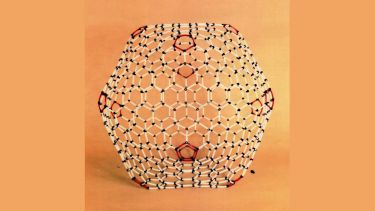Icosahedral carbon particles
A simple model building exercise led to the conclusion that closed large fullerenes would have quasi-icosahedral structures.

This was initially an arts project as Sir Harry Kroto wanted to build a large fullerene structure as a sculpture. Ken McKay found details of Gomberg’s icosahedra and built the beautiful models of C240 and C540.
To Kroto's surprise, they were not spheroidal like Buckminster Fuller’s Montréal dome. All the curvature was focused around the pentagons and surfaces between them were essentially flat. This resulted in an explanation of why spheroidal carbon particles have the quasi-icosahedral structures that had been observed.
This is a great example of an arts project resulting in a science breakthrough. An unusual situation!
Ed Applewhite also explained to Harry Kroto that only the top half of the Montreal dome was a BF dome. This explained why when he visited the site a second time in the 1990s, he was unable to find a pentagonal archway.
These beautiful structures were published without accreditation in the scientific American article, 'Fullerenes', Scientific American 256, 54 (October 1991).
H W Kroto and K McKay, (1988) 'The formation of quasi-icosahedral spiral shell carbon particles', Nature volume 331, pages 328–331.


